Ohio Do Not Resuscitate Order
This Ohio Do Not Resuscitate (DNR) Order follows the applicable laws set forth by the Ohio Revised Code regarding advance directives. This document is meant to ensure that your wishes regarding medical interventions are honored in the event of a medical emergency.
Patient Information:
- Patient's Full Name: _______________________________
- Date of Birth: _______________________________
- Address: ______________________________________
- Phone Number: _______________________________
Statement of Intent:
I, the undersigned, declare that I do not wish to receive cardiopulmonary resuscitation (CPR) in the event that my heart stops beating or if I stop breathing. This decision is made voluntarily and reflects my personal values and preferences.
Conditions for DNR Implementation:
This DNR order is to be followed only when I am unable to communicate my wishes due to a medical condition. It should not be enforced if I have a reasonable chance of recovery with appropriate medical intervention.
Signature:
- Patient's Signature: _______________________________
- Date: _______________________________
If applicable, the following individuals have participated in the discussion regarding this DNR order:
- Witness #1 Name: _______________________________
- Witness #1 Signature: _______________________________
- Date: _______________________________
- Witness #2 Name: _______________________________
- Witness #2 Signature: _______________________________
- Date: _______________________________
This order becomes effective immediately upon signature and remains in effect until revoked in writing. Please share this document with your healthcare provider to ensure your preferences are respected.
